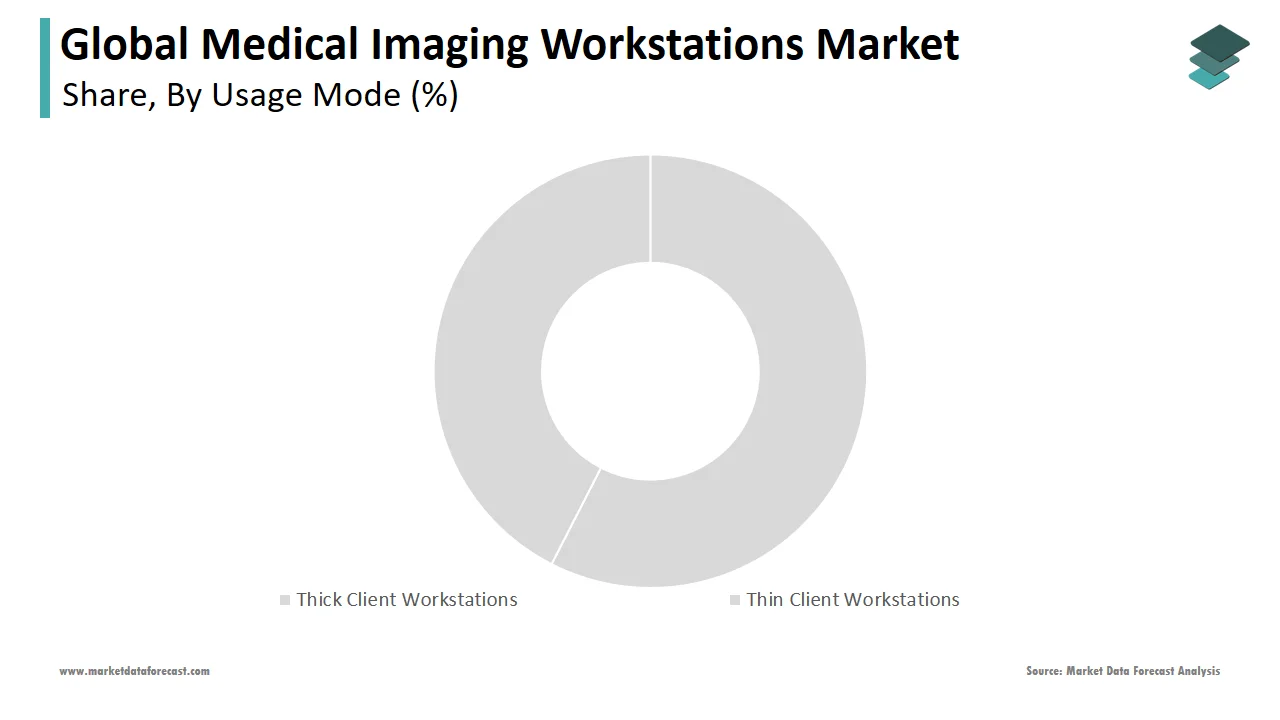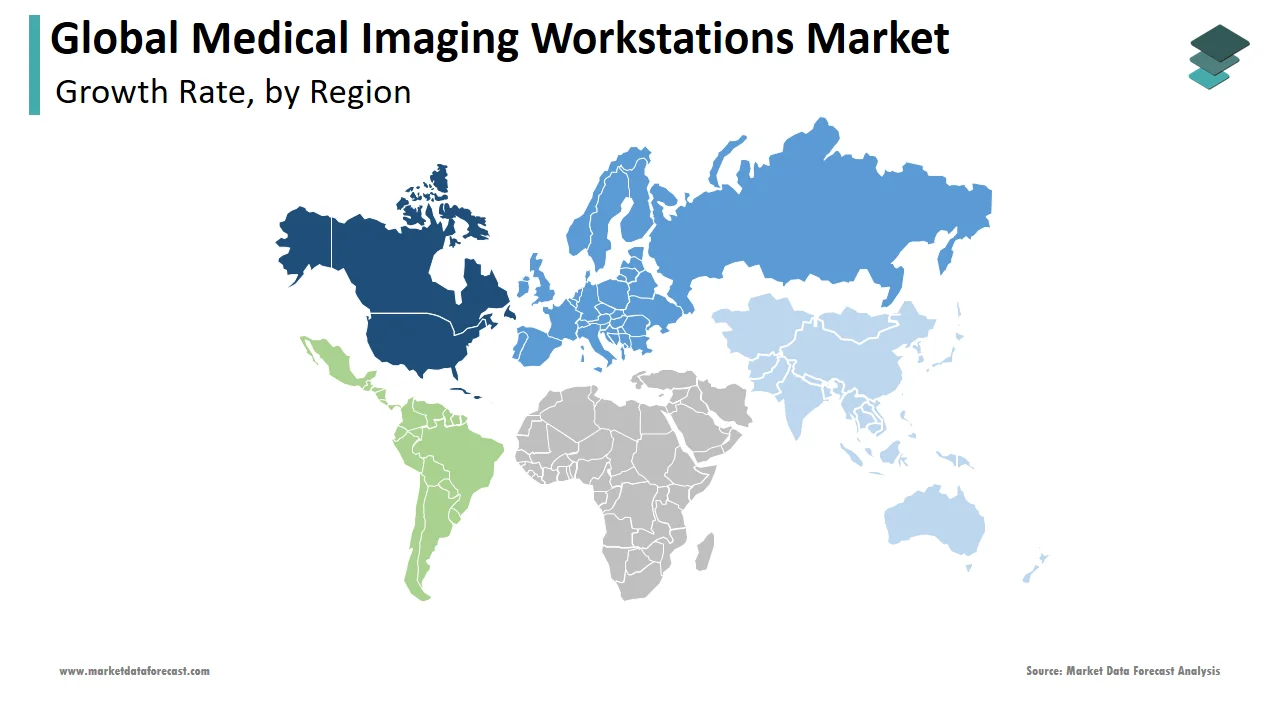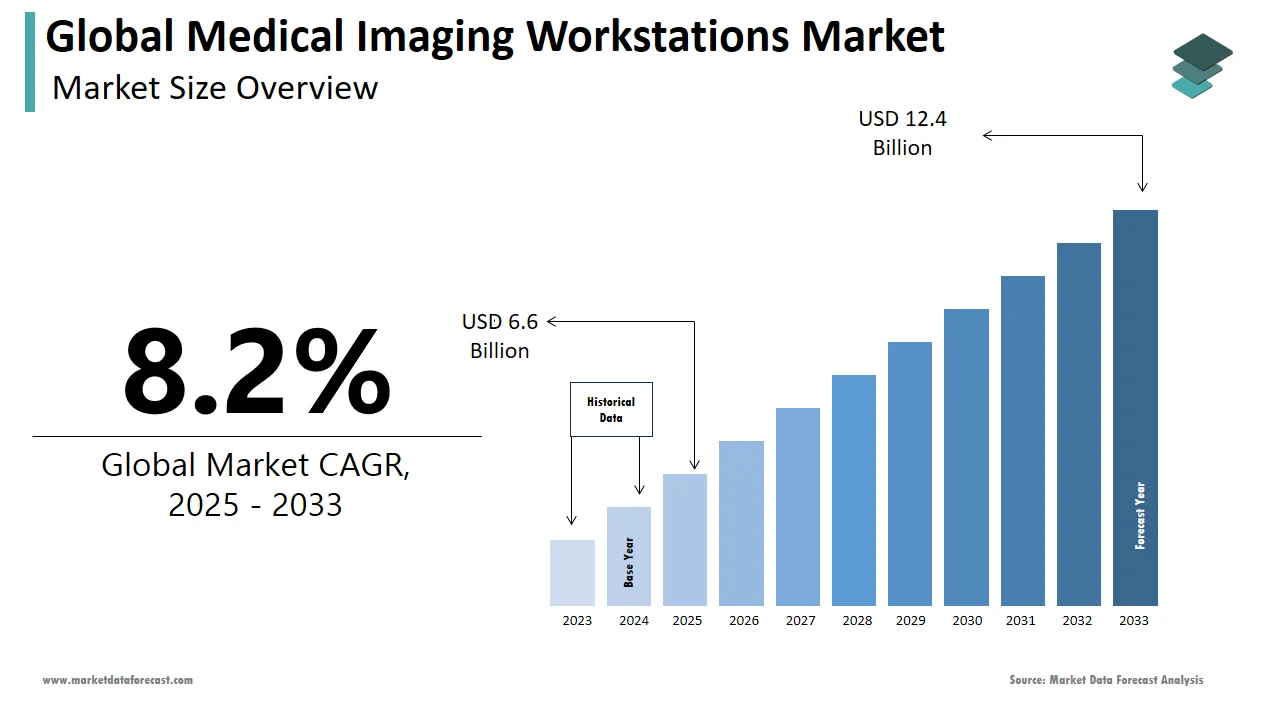Global Medical Imaging Workstations Market Size, Share, Trends & Growth Forecast Report By Usage Mode, Component, Application, Modality and Region (North America, Europe, Asia-Pacific, Latin America, Middle East and Africa), Industry Analysis From 2025 To 2033.
Global Medical Imaging Workstations Market Size
The global medical imaging workstations market was worth US$ 6.1 billion in 2024 and is anticipated to reach a valuation of US$ 12.4 billion by 2033 from US$ 6.6 billion in 2025, and it is predicted to register a CAGR of 8.2% during the forecast period 2025-2033.
MARKET DRIVERS
The growing patient population with chronic diseases primarily drives the medical imaging workstations market growth.
The prevalence of chronic diseases is growing significantly and the number of people suffering from chronic diseases such as cancer, cardiovascular disease, and neurological disorders is on the rise and causing a significant number of mortalities worldwide. In the same ratio, the need for medical imaging workstations is also growing, and these play a vital role in the diagnosis, treatment, and management of these conditions. As per the statistics published by the World Health Organization (WHO), an estimated 74% of deaths worldwide are due to chronic diseases. Using medical imaging workstations, a wide range of medical images such as X-rays, CT scans, MRI scans, and ultrasound scans can be processed and analyzed and these images play a key role in understanding the structure and function of organs and tissues. This information further helps healthcare professionals diagnose and monitor chronic diseases, develop treatment plans, and monitor treatment progress. Likewise, the demand for medical imaging workstations is anticipated to grow with the increasing prevalence of chronic diseases worldwide.
Technological advancements further fuel the growth rate of the medical imaging workstations market. Imaging modalities such as MRI, CT, ultrasound, and PET/CT have experienced several advancements in recent years due to technological advancements, and these advancements further resulted in better image quality, faster scanning times, and improved diagnostic accuracy in these imaging modalities. Artificial intelligence has been increasingly used to improve the accuracy, speed, and efficiency of medical imaging workstations. The algorithms developed integrating the capabilities of artificial intelligence can detect the abnormalities or changes that are difficult for a human to detect exactly. In addition, other technological advancements such as advanced visualization tools, including 3D imaging, virtual reality and augmented reality, and cloud-based medical imaging workstations and mobile solutions have further contributed to the market growth in recent years, and this trend is likely to accelerate in the coming years, and boost the market’s growth rate.
The growing aging population suffering from age-related conditions such as osteoporosis, Alzheimer's disease, and Parkinson's disease is propelling the demand for medical imaging workstations and contributing to market growth. The growing investments by several governments in healthcare infrastructure, including medical imaging equipment and workstations, is another key attribute fueling the market’s growth rate. The rising healthcare expenditure boosts the growth rate of the medical imaging workstation market. Healthcare expenditure is growing rapidly due to population growth, aging, and the growing prevalence of chronic diseases and resulting in the increased demand for medical imaging workstations. The growing awareness among healthcare facilities regarding the benefits of medical imaging workstations, such as improved accuracy, faster diagnosis, and greater efficiency, drives market growth.
Furthermore, the rising preference for minimally invasive surgeries that require detailed and accurate imaging data for successful outcomes, rapid adoption of telemedicine, especially in rural and remote areas, growing demand for portable imaging systems, increasing awareness of the importance of early diagnosis for successful treatment of many diseases, significant advancements in diagnostic imaging technology, including new modalities such as PET/CT and SPECT/CT and growing trend towards personalized medicine are anticipated to have a favorable impact on the medical imaging workstations market and support the market’s growth rate.
MARKET RESTRAINTS
The high costs associated with the development and maintenance of medical imaging workstations hamper the market growth primarily. Limited adoption of medical imaging workstations, challenges associated with integrating medical imaging workstations with existing healthcare systems, imaging modalities, and picture archiving and communication systems (PACS), and the scarcity of medical professionals hinder market growth. Furthermore, the stringent regulatory environment for medical imaging workstations, cybersecurity risks, limited reimbursement policies for medical imaging procedures in some countries, and interoperability issues impede the market growth.
Impact Of COVID-19 on The Global Medical Imaging Workstations Market
The COVID-19 pandemic has had a mixed impact on the medical imaging workstations market. During the COVID-19 pandemic, the need for medical imaging has grown significantly. The demand for medical imaging has increased during the COVID-19 pandemic with the increasing number of people infected with the coronavirus and resulting in the increased usage of X-rays, CT scans, and MRI scans. In addition, the increased usage of telemedicine has favored the growth of the medical imaging workstations market and resulted in the increased demand for medical imaging workstations that can be accessed remotely, allowing doctors to view and analyze medical images from home or other locations. Furthermore, the adoption of cloud-based medical imaging workstations has increased notably. Likewise, the global medical imaging workstations market has benefitted favorably from the COVID-19 pandemic. On the other hand, hospitals and healthcare facilities have diverted their resources towards the development of COVID-19 vaccines during the COVID-19 pandemic and given less priority to installing and upgrading medical imaging workstations, and this has shown an unfavorable impact on the market growth.
REPORT COVERAGE
|
REPORT METRIC |
DETAILS |
|
Market Size Available |
2024 to 2033 |
|
Base Year |
2024 |
|
Forecast Period |
2025 to 2033 |
|
CAGR |
8.2% |
|
Segments Covered |
By Usage Mode, Application, Component, Modality, and Region. |
|
Various Analyses Covered |
Global, Regional, and country-level analysis; Segment-Level Analysis, DROC; PESTLE Analysis; Porter’s Five Forces Analysis, Competitive Landscape; Analyst Overview of Investment Opportunities |
|
Regions Covered |
North America, Europe, APAC, Latin America, Middle East & Africa |
|
Market Leaders Profiled |
Accuray Incorporated, CANON MEDICAL SYSTEMS CORPORATION, Carestream Health, Carl Zeiss Meditec AG, FUJIFILM Holdings Corporation, GE Healthcare, Koninklijke Philips N.V., NGI Group, and Hologic, and Others. |
SEGMENTAL ANALYSIS
By Usage Mode Insights

Based on usage mode, the thick client workstation segment had the leading share of the worldwide market in 2024 and is expected to grow at a healthy CAGR during the forecast period. The rising demand for cloud-based imaging solutions and cost-effective imaging solutions that can be accessed from any location majorly boosts the growth rate of the segment. The benefits associated with using thick client workstations such as standalone, high-performance computer workstations, robust processing capabilities for medical imaging applications, powerful processors, large amounts of memory, and high-end graphics cards further add fuel to the segmental growth. On the other hand, the thin client workstation segment is anticipated to register the fastest CAGR during the forecast period. The growing demand for cloud-based solutions, rapid adoption of mobile devices, and increasing need for remote access to medical images and data primarily drive the segmental growth. In addition, the lower cost of ownership and maintenance of thin client workstations compared to thick client workstations contributes to the growth rate of the segment.
By Application Insights
Based on the application, the advanced imaging segment had the largest share of the global market in 2024, and this trend is anticipated to continue throughout the forecast period. The growing demand for personalized medicine that requires advanced imaging modalities for targeted diagnosis and treatment and the rising prevalence of chronic diseases such as cancer and cardiovascular diseases that require advanced imaging modalities for accurate diagnosis and treatment majorly fuel segmental growth. In addition, the rapid adoption of hybrid imaging modalities such as PET-CT and PET-MRI, which require advanced processing capabilities, and the increasing penetration of technological advancements in advanced imaging modalities such as improved image resolution and faster scan times contribute to the growth rate of the segment. The conventional imaging segment accounted for a moderate share of the global market in 2024 and is anticipated to register a steady CAGR during the forecast period. The growing prevalence of chronic diseases such as cancer, cardiovascular diseases, and neurological disorders that require frequent diagnostic imaging procedures is one of the key factors propelling segmental growth. In addition, the growing geriatric population, who are more susceptible to chronic diseases and require more frequent imaging and technological advancements in conventional imaging modalities such as digital X-ray and 3D/4D ultrasound, boost the growth rate of the segment. The rising demand for early diagnosis and preventive healthcare that requires frequent imaging is another major attribute that boosts segmental growth.
By Component Insights
Based on components, the hardware segment captured the leading share of the global market in 2024 and is expected to grow at a healthy CAGR during the forecast period. The growth of the segment is primarily attributed to the growing demand for high-performance computing hardware to handle the growing volume of medical images and the rapid adoption of technological advancements in hardware, such as high-resolution displays and advanced graphic cards. In addition, the growing adoption of mobile devices and cloud-based solutions and growing demand for custom-built medical imaging workstations that meet specific requirements of medical facilities contribute to the growth rate of the segment.On the other hand, the visualization software segment is expected to grow at a substantial CAGR during the forecast period due to factors such as the growing demand for advanced visualization software for processing and analyzing medical images, technological advancements in visualization software such as 3D rendering and virtual reality and rising adoption of telemedicine and remote imaging that require advanced visualization software for remote viewing and analysis.
By Modality Insights
Based on the modality, the computed tomography (CT) segment is expected to dominate the market during the forecast period owing to factors such as the growing patient population of chronic diseases, the increasing number of technological advancements in CT technology and the adoption of artificial intelligence (AI) in medical imaging.
REGIONAL ANALYSIS

Geographically, the North American region dominated the global market in 2024 and occupied the largest share of the worldwide market. The domination of the North American market is expected to continue during the forecast period and primarily due to high healthcare expenditure, increasing healthcare awareness among patients, the presence of established healthcare infrastructure, favorable reimbursement policies and the rising prevalence of chronic diseases such as cancer and cardiovascular diseases. In addition, the growing adoption rate of advanced medical imaging technologies and an increasing number of partnerships and collaborations between the market participants further accelerate the growth rate of the North American market. The U.S. had the largest share of the North American market in 2024 and is expected to grow at a promising CAGR during the forecast period. The growth of the U.S. market is majorly driven by the presence of key market players and favorable reimbursement policies. On the other hand, the Canadian market is anticipated to witness a healthy CAGR during the forecast period. Factors such as the increasing geriatric population and growing prevalence of chronic diseases.
Europe is another promising regional market for medical imaging workstations and is estimated to occupy a notable share of the worldwide market during the forecast period. Strong government support for research and development in medical imaging technologies, rising emphasis on patient-centric healthcare services and rising adoption of digital imaging technologies boost the growth rate of the European market. The presence of key market players, such as Siemens Healthineers, Philips Healthcare and GE Healthcare and an increasing number of mergers and acquisitions among key players in Europe further favor the growth rate of the European market. Germany held the major share of the European market in 2024 and is predicted to grow at a healthy CAGR during the forecast period. The growth of the German market is primarily driven by the presence of key market players and high healthcare expenditure. The UK is another lucrative regional market for medical imaging workstations and is estimated to occupy a substantial share of the European market during the forecast period.
APAC is the most lucrative regional market for medical imaging workstations and is expected to register the fastest CAGR among all regions in the worldwide market during the forecast period. Factors such as the rapidly growing geriatric population, increasing prevalence of chronic diseases, rising emphasis on improving healthcare infrastructure, increasing healthcare spending by governments in the region and growing adoption of advanced medical imaging technologies in developing economies propel the regional market growth.
KEY MARKET PLAYERS
Accuray Incorporated, CANON MEDICAL SYSTEMS CORPORATION, Carestream Health, Carl Zeiss Meditec AG, FUJIFILM Holdings Corporation, GE Healthcare, Koninklijke Philips N.V., NGI Group, and Hologic are some of the major players in the market.
RECENT MARKET HAPPENINGS
- Affidea, a supplier of advanced diagnostic imaging, cancer care, and outpatient services, partnered with GE in December 2019. The goal of the partnership was to implement digital and image technologies across the Affedia Network.
- In December 2019, Zeiss announced a collaboration with Arivis AG, a software firm. The partnership aimed to provide complete 3D imaging systems solutions.
- In September 2018, Philips and the Illawarra Shoalhaven Local Health District and the Nepean Blue Mountains Local Health District in New South Wales agreed.
MARKET SEGMENTATION
This research report on the global medical imaging workstations market has been segmented and sub-segmented based on usage mode, application, component, modality, and region.
By Usage Mode
- Thick Client Workstations
- Thin Client Workstations
By Application
- Conventional Imaging
- Advanced Imaging
By Component
- Visualization Software
- Hardware
By Modality
- Computed Tomography (CT)
- Magnetic Resonance Imaging (MRI)
- Ultrasound
- Mammography
By Region
- North America
- Europe
- Asia-Pacific
- Latin America
- The Middle East and Africa
Frequently Asked Questions
What is the market size worth in 2023?
The size of the global medical imaging workstations market is valued at USD 6.1 billion in 2024.
At what CAGR, the medical imaging workstations market is projected to grow during the forecast period?
The size of the global medical imaging workstations market is projected to grow at a CAGR of 8.2% during the forecast period 2025 to 2033.
By component, which segment is predicted to grow at a substantial CAGR during the period?
Based on the component, the visualization software is predicted to grow at a substantial CAGR during the forecast period from 2025 to 2033.
Who are the keyplayers operating the medical imaging workstations market?
Accuray Incorporated, CANON MEDICAL SYSTEMS CORPORATION, Carestream Health, Carl Zeiss Meditec AG, FUJIFILM Holdings Corporation, GE Healthcare, Koninklijke Philips N.V., NGI Group,tions LLC, and Hologic are some of the key market players operating the market.
Related Reports
Access the study in MULTIPLE FORMATS
Purchase options starting from
$ 2500
Didn’t find what you’re looking for?
TALK TO OUR ANALYST TEAM
Need something within your budget?
NO WORRIES! WE GOT YOU COVERED!
Call us on: +1 888 702 9696 (U.S Toll Free)
Write to us: sales@marketdataforecast.com

